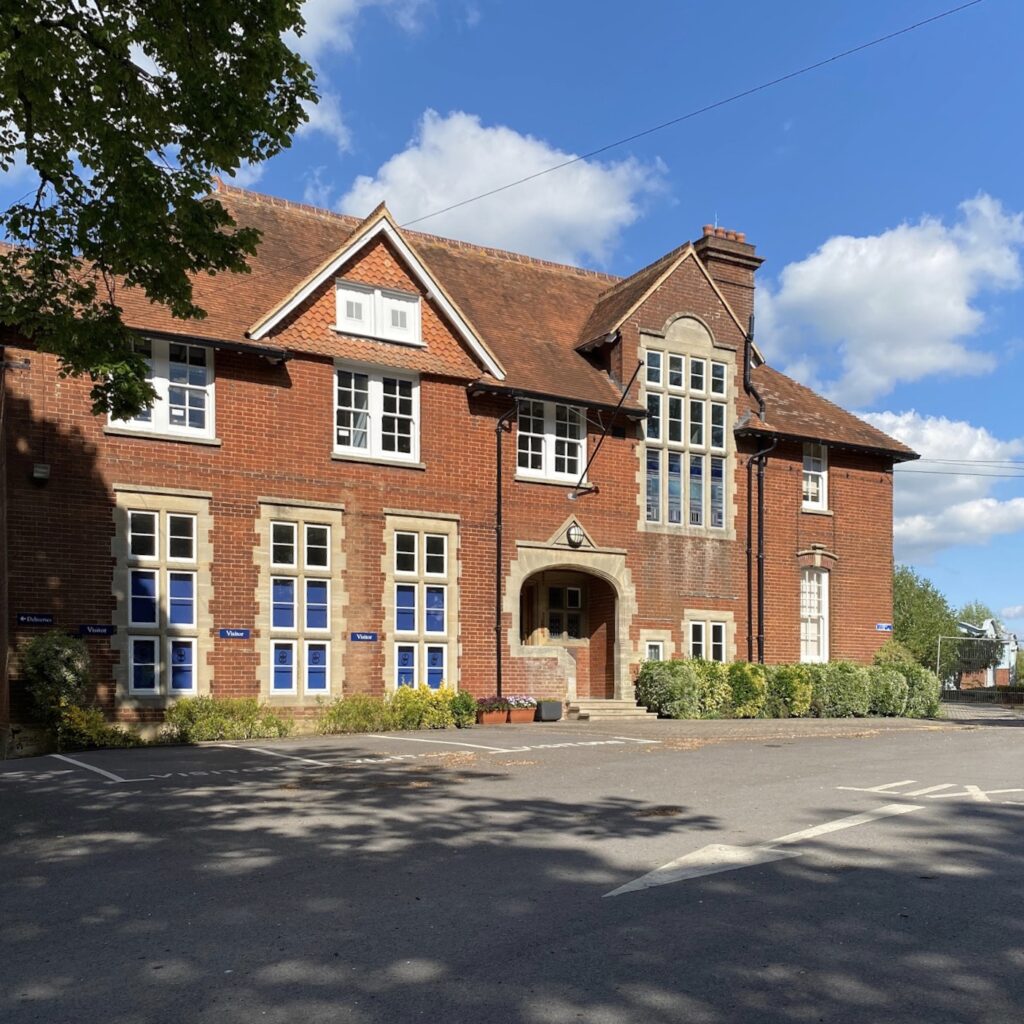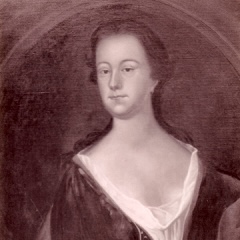Elizabeth Godolphin (bap.1663-1726)
The renowned Godolphin School in Salisbury derives its name from Elizabeth Godolphin who was its benefactor and took an active interest in girl’s education. The Godolphin family lived in Cornwall from the 11th century and took their name from the Manor of Godolghan meaning ‘White Eagle’ in Cornish. The main branch of the family lived in Godolphin House (near Helston) and family wealth was derived from tin mines.
Elizabeth’s home was in Coulston, near Edington in Wiltshire. The house is now called Baynton House. She was baptized on 5th November 1663 at Coulston Church, the third of five children of Francis Godolphin (1629-1670) and his wife Elizabeth (1633-1667).
Elizabeth had to cope with a number of tragedies during her 63 years, not least the early death of her parents, the death of siblings and then the early death of her own children. Both of her parents died whilst Elizabeth was quite young and she was placed in the guardianship of her uncle, Sir William Godolphin (1635-1696) who became Charles II’s ambassador to Spain in 1669. With his move to Spain Elizabeth was then looked after by her great uncle Francis Bluet and his wife Elizabeth.
Further tragedies occurred when her brother William died in a duel in 1682. Francis, her other brother, inherited the estate but took his own life in 1702. Coulston House was placed in the hands of trustees who were made responsible for Elizabeth’s dowry.
On the 27thJune 1687 at the age of 24, Elizabeth married Charles (1651-1720), her second cousin once removed. They married in the Church of St Martins-in-the-Fields in London. Charles was MP for Helston and Senior Commissioner for Customs in London. They purchased a house in St James’s Street, Piccadilly, London and retained the house in Coulston. By all accounts it was a happy marriage but marred by the early deaths of their children; Anne aged 2 years (who died in 1690) and William aged 2 months (who died in 1694). After these sad events, Charles’s great niece Frances (Fanny) Quicke, the granddaughter of his sister, Elizabeth, Lady Northcote, went to live in London with Elizabeth and Charles until her own marriage. She became in effect their surrogate daughter.
The 17th and 18th centuries saw an increase in the number of girls’ schools in England. Both Elizabeth and Charles took an interest in this cause: they founded a number of charities and developed a charitable foundation after Elizabeth received her uncle’s inheritance and her own children had died. Elizabeth was keen that the school was located in Salisbury Cathedral Close under the trusteeship of the Dean and Chapter but there were problems with this plan. Initially the Dean and Chapter refused to co-operate and the school did not open until 1784, many years after Elizabeth’s death.


Charles Godolphin died on the 10th of July 1720 and left the bulk of his estate to Elizabeth. Elizabeth survived him by another 6 years. The foundation of Godolphin school occupied her during the remaining part of her life. Several sources describe Elizabeth’s personality and character,1 and her strong personality probably would have facilitated her efforts towards founding Godolphin school. She fought to get the school established, if not in Salisbury, then in some other part of Wiltshire. She made her nephew promise that her wishes would be carried out. She left a detailed will setting out the background, sums to be allocated and instructions for running the school. In terms of the curriculum Elizabeth favoured dancing, reading, writing, casting accounts, housewifery and attendance at church services. Pupils were to be 12-19 years and should be ‘gentlewomen borne of parents of the Church of England and such as have some portion left them not exceeding four hundred pounds.’2
Elizabeth died 29th July 1726 and was buried alongside Charles and their two children in the West cloister of Westminster Abbey. Elizabeth and Charles are commemorated in a fine mural tablet in the cloisters, celebrating their virtues (including their charity and benevolence) and the founding of the school.3
On 12th July 1784 the Salisbury Journal announced that the Godolphin School would open on the 9th August of that year. The ‘genteel house’ was originally sited in Rosemary Lane,
No. 25 The Close. It remained there for over 50 years. In 1836 the school moved to Arundells (No. 59) and then to the King’s House. In 1848 there was an outbreak of cholera in Salisbury and probably because of this the decision was taken to move again to the city outskirts, firstly to the top of St Ann Street and then to Milford Villa, Shady Bower.
The school has grown over the years and today has well in the region of 450 pupils. There was a substantial increase in numbers under the headship of Mary Alice Douglas 4 (Head Teacher 1890-1919) who is sometimes regarded as its second founder. In 1928, together with the headmistress of the time, she released a book about the school and its history.5 Many of the school’s diaries have been archived at the Wiltshire and Swindon History Centre.6
Famous alumni of the school include Dorothy L Sayers (1893 -1957),7 Jilly Cooper, Deborah Meaden and Minette Walters. The monument to Elizabeth and Charles can still be found today at Westminster Abbey and pupils from Godolphin School lay a wreath there bi-annually.
Research for this profile was undertaken by Susan Brain and Molly Say. Profile by Susan Brain.
We would like to thank Godolphin School for use of the image of Elizabeth Godolphin.
Notes
1 The Oxford Dictionary of National Biography describes Elizabeth as ‘a formidable, tough, and autocratic woman renowned for her wit, she acted as arbitrator in family disputes but did not suffer fools gladly and could be a difficult neighbour, as her next-door neighbour Thomas Coke discovered when building his own house in St James’s Street.’
Elizabeth Dimont describes Elizabeth Godolphin ‘as a woman of integrity, honesty and compassion. She was caring of her servants, the poor and those in distress.’ ‘Elizabeth was neither beautiful nor pretty, but small, dark haired, dark eyed and extremely intelligent. She acquired a reputation for wit as she grew up.’ Diment goes on to say ‘in maturity her character was strong and forceful; determination to have her own way, to fulfil any undertaking she had set her heart on.’ and ‘She was respected for her clear sighted views and her decisions’.
2 A copy of the will can be accessed via the Wiltshire and Swindon History centre; reference 4312/1/C/1. Also details of the will can be found in the Godolphin Book (1726-1926), edited by M.A. Douglas and C.R. Ash – see note 5.
3 More information about the memorial and the inscription can be found at the following link: https://www.westminster-abbey.org/abbey-commemorations/commemorations/godolphin-family
4 You can read our profile on Mary Alice Douglas here: https://hersalisburystory.com/stories/mary-alice-douglas/
5 M.A. Douglas & C.R. Ash (Eds). 1928. The Godolphin School, 1726-1926. Longmans, London. The book contains information about Elizabeth Godolphin, the history of the school, and memories and recollections from staff and pupils of the school. Copies of the book are held at Wiltshire libraries and the Wiltshire and Swindon History Centre.
6 The Wiltshire and Swindon History Centre holds a collection of documents from Godolphin school. The types of records that are held can be explored using the archive’s online catalogue: http://calmview.wiltshire.gov.uk/CalmView . The collection relating to Goldolphin school has the reference number 4312.
7 You can read our profile on Dorothy L. Sayers here: https://hersalisburystory.com/stories/historic/dorothy-l-sayers/
Sources
Dimont, E (1987) Godolphin family portraits, 1610-1781
Fraser, V. M. (1976) Godolphin School 1726-1976
Godolphin History https://www.godolphin.org/community/history
Oxford Dictionary of National Biography (2008) https://www.oxforddnb.com/view/10.1093/ref:odnb/9780198614128.001.0001/odnb-9780198614128-e-95354
Westminster Abbey https://www.westminster-abbey.org/abbey-commemorations/commemorations/godolphin-family#i15194
Wikipedia (2021)
https://en.wikipedia.org/wiki/Elizabeth_Godolphin
Wiltshire OPC (2017) History of Godolphin School, Milford hill.
https://www.wiltshire-opc.org.uk/Items/Milford/Milford%20-%20Godolphin%20School.pdf
Wiltshire and Swindon History Centre (2016) Delving into the Godolphin School Archive https://wshc.org.uk/blog/item/delving-into-the-godolphin-school-archive.html

